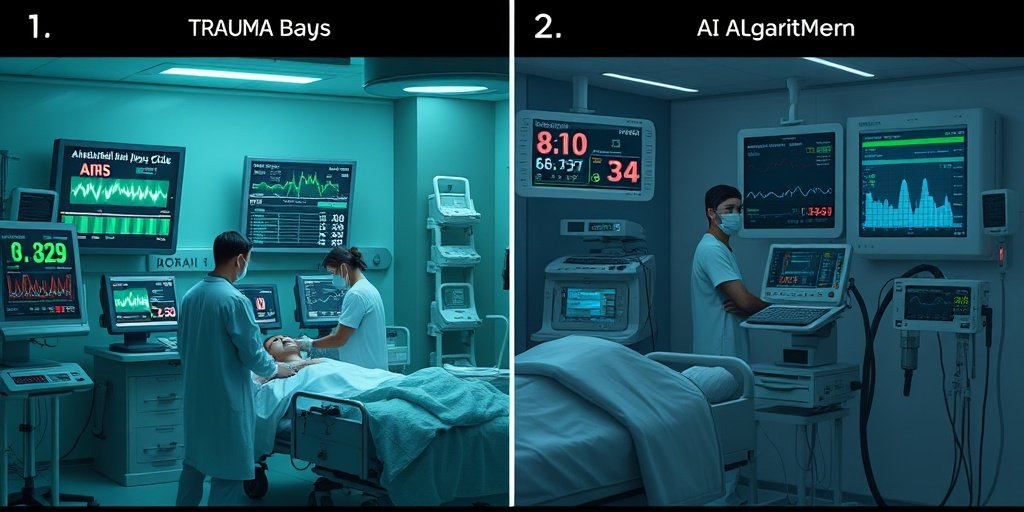⚡ Quick Summary
This study examined the predictive values of clinical measurements taken at admission and in the ICU for complications and mortality in severely injured patients. The findings revealed that the timing of measurements significantly influences their predictive quality, with different parameters being more relevant at each stage.
🔍 Key Details
- 📊 Dataset: 3,668 severely injured patients
- 🧩 Inclusion Criteria: ISS ≥ 16 points, primary admission, complete data set
- ⚙️ Methods: Adaptive boosting (AdaBoost) and LASSO regression analysis
- 🏆 Primary Outcomes: Mortality, pneumonia, sepsis
🔑 Key Takeaways
- 📈 Overall mortality rate was found to be 26.8% among the studied patients.
- 💡 Admission parameters such as abbreviated injury scale (AIS) and new injury severity score (NISS) were highly predictive of complications.
- 🔬 ICU parameters like late lactate values and CRP showed better predictive quality for adverse outcomes.
- 📊 Sensitivity and specificity of late prediction models were 73.61% and 76.24%, respectively.
- 🧪 Study highlights the importance of timing in clinical assessments for trauma patients.
- 🌍 Conducted at a Level 1 academic trauma center.
- 🆔 Level of Evidence: III (retrospective cohort study).

📚 Background
Predicting outcomes in severely injured patients is a critical aspect of trauma care. Previous studies have primarily focused on single variables or admission values, often overlooking the dynamic nature of clinical parameters over time. This study aims to bridge that gap by comparing the predictive values of multiple routine clinical measurements taken at different time points.
🗒️ Study
The research was conducted as a retrospective cohort study at a Level 1 academic trauma center, focusing on patients with severe injuries (ISS ≥ 16 points). The study included a comprehensive analysis of clinical parameters recorded at admission and 72 hours post-admission in the ICU, aiming to assess their predictive capabilities for complications and mortality.
📈 Results
The study included a total of 3,668 cases, with an overall mean age of 45.5 ± 20 years and a mean ISS of 28.2 ± 15.1 points. The incidence of pneumonia was 19.0%, sepsis 14.9%, and deaths due to hemorrhagic shock and multiple organ failure were 4.1% and 1.9%, respectively. The results indicated that the predictive quality of clinical measurements varies significantly based on the timing of the assessment.
🌍 Impact and Implications
The findings of this study underscore the necessity of considering the timing of clinical measurements in trauma care. By recognizing that different parameters hold varying predictive values at admission versus during ICU stay, healthcare professionals can make more informed decisions regarding patient management and potential surgical interventions. This could lead to improved outcomes for severely injured patients and enhance the overall quality of trauma care.
🔮 Conclusion
This study highlights the critical role of timing in the predictive quality of clinical measurements for severely injured patients. As the dynamics of pathophysiologic responses evolve, so too must our approach to monitoring and decision-making in trauma care. Future research should continue to explore these dynamics to further refine predictive models and improve patient outcomes.
💬 Your comments
What are your thoughts on the importance of timing in clinical assessments for trauma patients? We invite you to share your insights and engage in a discussion! 💬 Leave your comments below or connect with us on social media:
Are the same parameters measured at admission and in the ICU comparable in their predictive values for complication and mortality in severely injured patients?
Abstract
INTRODUCTION: Numerous studies have investigated variables that predict mortality and complications following severe trauma. These studies, however, mainly focus on admission values or a single variable. The aim of this study was to investigate the predictive quality of multiple routine clinical measurements (at admission and in the ICU).
METHODS: Retrospective cohort study of severely injured patients treated at one Level 1 academic trauma centre.
INCLUSION CRITERIA: severe injury (ISS ≥ 16 points), primary admission and complete data set. Exclusion criteria end-of-life treatment based on advanced directive, secondary transferred patients.
PRIMARY OUTCOME: mortality, pneumonia, sepsis. Routine clinical parameters were stratified based on measurement timepoint into Group TB (Trauma Bay, admission) and into Group intensive care unit (ICU, 72 h after admission). Prediction of complications and mortality were calculated using two prediction methods: adaptive boosting (AdaBoost, artificial intelligence, AI) and LASSO regression analysis.
RESULTS: Inclusion of 3668 cases. Overall mean age 45.5 ± 20 years, mean ISS 28.2 ± 15.1 points, incidence pneumonia 19.0%, sepsis 14.9%, death from haemorrhagic shock 4.1%, death from multiple organ failure 1.9%, overall mortality rate 26.8%. Highest predictive value for complications for Group TB include abbreviated injury scale (AIS), new injury severity score (NISS) and systemic Inflammatory Response Syndrome (SIRS) score. Highest predictive quality for complications for Group ICU include late lactate values, haematocrit, leukocytes, and CRP. Sensitivity and specificity of late prediction models using a 25% cutoff were 73.61% and 76.24%, respectively.
CONCLUSIONS: The predictive quality of routine clinical measurements strongly depends on the timepoint of the measurement. Upon admission, the injury severity and affected anatomical regions are more predictive, while during the ICU stay, laboratory parameters are better predictor of adverse outcomes. Therefore, the dynamics of pathophysiologic responses should be taken into consideration, especially during decision making of secondary definitive surgical interventions.
LEVEL OF EVIDENCE: III (retrospective cohort study).
Author: [‘Gröbli L’, ‘Kalbas Y’, ‘Kessler F’, ‘Hax J’, ‘Michel T’, ‘Sprengel K’, ‘Pfeifer R’, ‘Mächler M’, ‘Pape HC’, ‘Halvachizadeh S’, ‘Klingebiel FK’]
Journal: Eur J Med Res
Citation: Gröbli L, et al. Are the same parameters measured at admission and in the ICU comparable in their predictive values for complication and mortality in severely injured patients?. Are the same parameters measured at admission and in the ICU comparable in their predictive values for complication and mortality in severely injured patients?. 2025; 30:228. doi: 10.1186/s40001-025-02477-8